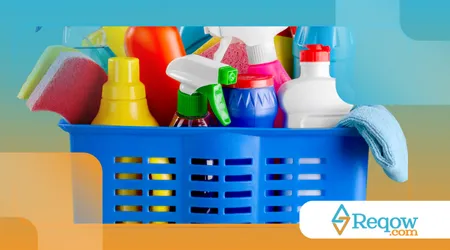Precautions to avoid household poisoning

Avoid household poisonings. In the search for a safe and welcoming home, we often neglect the invisible dangers that lurk in closets and on shelves.
Advertisements
The truth is that safety begins with prevention, and knowing how avoid household poisonings It is crucial for the health of everyone who lives under your roof.
The home environment, although it may seem harmless, harbors a variety of substances that, if misused or stored improperly, can become major threats.
Why is Poison Prevention Such an Urgent Matter?
Poisoning, whether from cleaning products, medications, or cosmetics, is a silent emergency.
Most cases occur with young children, who explore the world by putting objects and substances in their mouths out of natural curiosity.
Advertisements
Protecting these little explorers is an ongoing responsibility that requires constant vigilance.
In many homes, the rush and lack of attention in daily life create vulnerabilities.
Leaving a bottle of bleach open or storing medicine in a kitchen drawer are common oversights, but with potentially serious consequences.
Reflecting on our storage habits is the first step towards change.
The risk is not limited to children; adults can also be victims of accidents.
Read more: Prevention of common diseases in apartment dogs
Packaging mix-ups, accidental ingestion of toxic products packaged in soda bottles, or the improper use of household pesticides are scenarios that illustrate this reality.
Being informed and acting proactively is our best defense.
Where the Dangers Are Hidden: Who Are the Biggest Domestic Villains?
Have you ever stopped to think about the variety of dangerous products you keep at home? The most common cause of incidents is, undeniably, cleaning products.
Detergents, concentrated disinfectants, and especially the dangerous combination of bleach and ammonia, which release toxic gases when mixed, are the main culprits in many accidents.
Another silent villain is medication. Keeping painkillers and vitamins by the bedside, for example, is an open invitation for accidental ingestion.
Accessibility facilitates correct use, but at the same time, it increases the risk of inappropriate dosages or consumption by those who should not use it.
Find out more: How to prevent tick-borne diseases
Cosmetics and personal hygiene items also require attention.
Nail polishes, nail polish removers, and perfumes, which contain high levels of alcohol and other solvents, can cause respiratory problems and poisoning if inhaled or ingested.
Even organic and natural products can be toxic if consumed in excess.

How to Create a “Protective Shield”: Smart Strategies for avoid household poisonings?
Adopting security measures doesn't have to be complex. Think of your house as a castle; you should protect the access points.
The first and most essential measure is the safe storage of all chemicals and medications.
Look how interesting: Special care for brachycephalic dogs (flat-faced)
Invest in lockable cabinets or cabinets with safety latches, especially those that are below a child's eye level.
Keep dangerous items out of sight and reach, preferably on the highest shelves. This simple habit drastically reduces the chances of accidents.
Never remove products from their original packaging. This is a very serious mistake, as the packaging contains vital information and the safety label.
Furthermore, packaging a chemical product in a soda bottle is the most common scenario for accidental ingestion by adults and children.
Imagine you're cleaning the house and you answer the phone.
Leaving a container of caustic soda open in the sink is a lapse in attention that may only last a minute, but that's enough time for a curious child.
Another example: Grandma keeps her blood pressure pills in a colorful jewelry box that looks like a toy. The visual appeal is a disguised danger.
What do science and statistics tell us about home safety?
The importance of prevention is undeniable. According to data from the National System of Toxicological and Pharmacological Information (Sinitox), cleaning products and medications are consistently the leading causes of poisoning in Brazilian homes.
The research highlights the urgent need for awareness.
In 2023, Sinitox highlighted that accidents involving cleaning products accounted for approximately 101% of the total reported cases of human poisoning in the country, reinforcing the importance of... avoid household poisonings focusing on this group of substances. avoid household poisonings It should be a priority.
Table: Examples of Secure Storage Locations
| Product Category | Ideal Location (High and Secure) | Location to Avoid (Accessible) |
| Cleaning Products | Upper laundry cabinet with lock. | Below the kitchen or bathroom sink |
| Medicines | Lockable wardrobe in the parents' bedroom. | Chest of drawers or bedside table drawer |
| Pesticides/Rodenticides | High, insulated shelf in the garage. | Unprotected service area |
What is the Importance of Reading Labels for avoid household poisonings?
Careful reading of labels is like having a safety map. Many accidents happen because people ignore instructions for use and hazard warnings.
The label provides information about the composition, the risks, and, most importantly, what to do in case of contact or ingestion.
Like a pilot who checks all instruments before takeoff, you should check safety information before using any chemical product.
This includes the use of gloves and adequate ventilation, as recommended. This simple precaution can... avoid household poisonings serious.
Analogously, the risk of poisoning at home is like a fuse that can blow at any moment.
If you don't address the issue of overload (easy access, inadequate packaging), the safety system (your family's health) will be compromised.
We need to be the firefighters of our own home, acting before the fire starts.

What to do in case of emergency and how to act?
Despite all precautions, accidents happen. In those moments, calm and quick action are essential.
The first step is to immediately call the Poison Control Center (CIATox) in your region or the Mobile Emergency Care Service (SAMU) by dialing 192.
Do not attempt home remedies, such as inducing vomiting, unless specifically instructed by a healthcare professional.
Keep the product packaging or the medication leaflet on hand, as the active ingredient is crucial information for treatment.
Acting quickly, without panicking, significantly increases the chances of a positive outcome.
Isn't it true that most poisonings could be avoided with a little more caution?
An Ongoing Commitment to avoid household poisonings
Home security is an ongoing project, not a one-time event.
Adopting the practices for avoid household poisonings It requires discipline and ongoing education from all family members.
By making secure storage a habit, not a chore, we build a truly protected environment.
Prioritizing chemical and pharmaceutical safety is an act of love and responsibility.
Frequently Asked Questions
1. Is it safe to store cleaning products in the cabinet under the sink?
It's not ideal, especially if there are young children.
This area is easily accessible and is usually at their eye level. Ideally, it should be stored in high, locked locations.
2. Can I mix bleach with disinfectant to enhance cleaning?
Never. Mixing cleaning products, especially those containing chlorine (bleach) and ammonia, can release toxic gases that cause serious respiratory problems and inhalation poisoning.
3. What should you do immediately after ingesting a chemical?
Stay calm, do not induce vomiting, and immediately call 192 (SAMU - Brazilian emergency medical service) or the Poison Control Center (CIATox) in your area. Keep the product packaging with you.
4. How can I make sure my children can't open the medicine cabinet?
Use child safety locks, which are sold in baby and home goods stores, and combine this with storing items on a high shelf that is out of the child's visual and physical reach.
++ Taking care of your pet during pest control in your environment.
